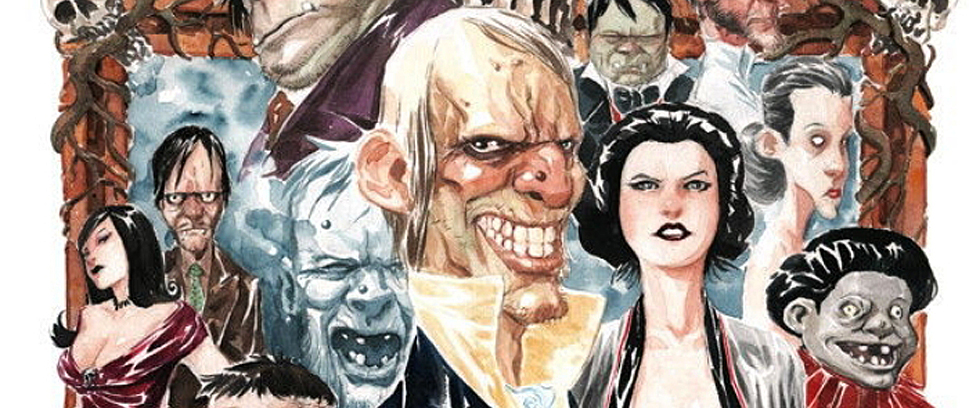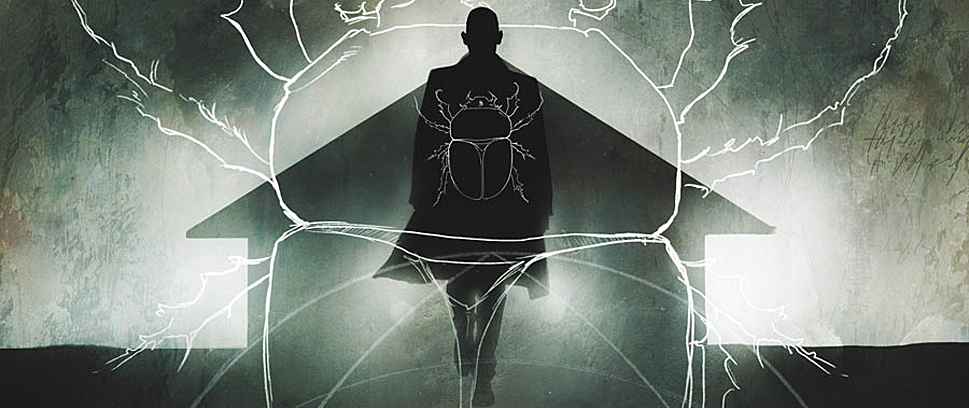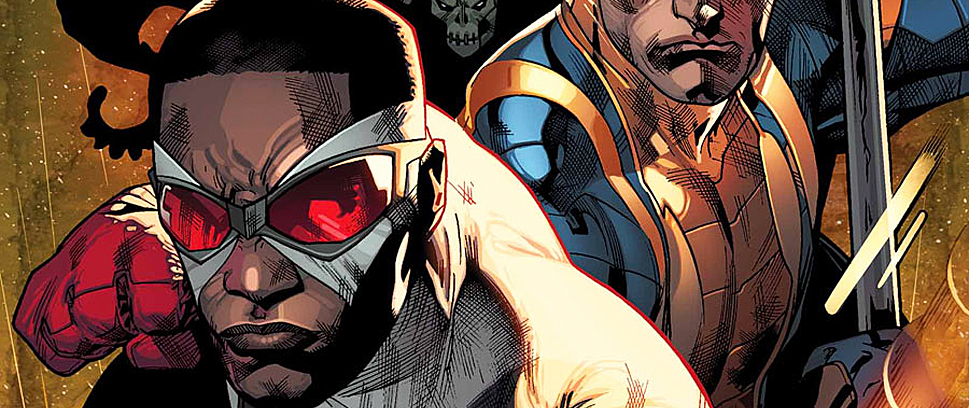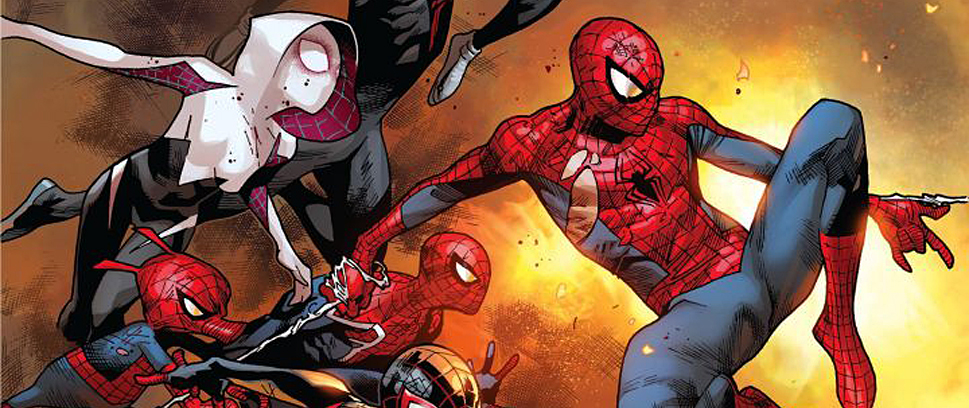
Last Week’s Comics 1/28/2015
Amazing Spider-Man #13
(Marvel – writer: Dan Slott; artist: Giuseppe Camuncoli)
I’ve been enjoying Dan Slott’s “Spider-Verse” so far. I love the way he’s intertwined all these versions of Spider-Man into one epic story that centers on a villain known to give Spider-Man a continuously difficult time due to his penchant for beating the crap out of our hero. So in the second-to-last issue of the arc, Dan Slott moves all of his pieces into play as he gears up for the conclusion. Unfortunately, it isn’t as smooth as the previous issues.
 Issue #13 of Amazing Spider-Man is a bit of a pacing snafu. Scott transitions his tale several times between worlds, but not seamlessly. It’s not that the tale is hard to follow, but after last month’s issue of continuous action and cool set pieces, sitting still in one place for too long, especially when several scenes drag on for longer than they need to, makes the comic a bit tedious.
Issue #13 of Amazing Spider-Man is a bit of a pacing snafu. Scott transitions his tale several times between worlds, but not seamlessly. It’s not that the tale is hard to follow, but after last month’s issue of continuous action and cool set pieces, sitting still in one place for too long, especially when several scenes drag on for longer than they need to, makes the comic a bit tedious.
Plus, Morlun and his family’s motivations are revealed to be part of some prophecy that will end the Spider lineage, but the family kind of subsists on the totems, so why would they want them gone? The plot hole isn’t addressed – yet – but this kind of question negates all the fun of “Spider-Verse.” Furthermore, the heroes play right into the hands of their enemies, which works well for Slott as he tries to build suspense for the finale, but which feels like a cheap ploy to build to a forced climax.
Giuseppe Camuncoli has less to work with in this issue, too, as much of the story takes place in a protected hideout where the Spider-Men and Spider-Women discuss their plan for the final confrontation. When he gets the opportunity, though, Camuncoli takes advantage of his numerous Spider-Characters to craft some solid action. I especially liked Kaine’s fight with Morlun’s family. The new design of the character is both scary and gross, and seeing these super-powered monsters throw down against each other was the most fun of the issue.
The next issue of the series is the conclusion, so hopefully Slott does more than have his characters sit around and talk for the majority of the issue. Many of the ideas in this comic are rehashed from earlier issues in “Spider-Verse,” and Slott is obviously trying to build suspense before he launches into the climactic finale, but the results are less than exciting. But this is a misstep in a series that’s been otherwise extremely entertaining, so hopefully Slott rights the ship with the final issue of “Spider-Verse” next month.
———
Justice League #38
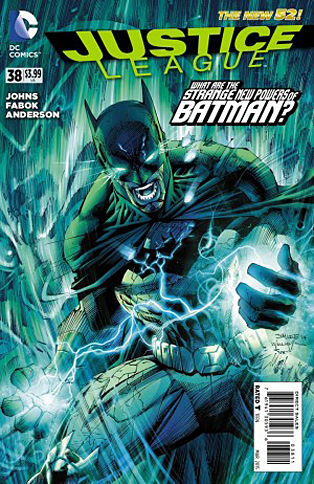 (DC – writer: Geoff Johns; artist: Jason Fabok)
(DC – writer: Geoff Johns; artist: Jason Fabok)
Last month, Geoff Johns gave us a stellar issue of Justice League that ended with Batman being infected by the Amazo Virus, a sickness that gives super powers to mortal humans while stripping the powers of other heroes. So with the Justice League down for the count (save for Superman and Wonder Woman), and Patient Zero on the loose, DC’s three heaviest hitters look for a way to save their compatriots with the clock ticking.
Johns loves to write a good mystery, but Justice League #38 doesn’t really have that – at least not initially. The Amazo Virus was created by Lex Luthor, and I bet you can guess why. The way it affects people, however, is what’s most interesting about it. We learn a bit more about the virus this issue, but what’s more intriguing is the way the virus is starting to take shape. By the end of the issue, Superman, Wonder Woman and Lex Luthor have a pretty serious situation on their hands, and given Johns’ solid pacing and great cliffhanger, it’s going to be a frustrating month waiting for issue #39.
What Johns does best, though, is to expand the characterization of his secondary characters, namely Captain Cold. Johns is great at finding ways to make simple villains with usually silly powers seem like serious and viable threats. Cold’s explanation of his abilities as he faces off with a potential assassin makes him a much cooler character than he appears on first glance. His role in the story has yet to be fully realized, but I think many people will be Captain Cold fans by the end of the issue.
The best part of Justice League #38, however, is Jason Fabok. Every page is awash with intricate detail and stellar character designs. There’s a cleanliness to his style, one that works particularly well with the grimy, desolate streets of Metropolis. The final page is the stuff of nightmares. Clearly, Fabok knows how to draw a comic that makes the heroes look heroic, the villains look formidable and helps the pacing of the story. Plus, with Brad Anderson’s colors giving the comic a polished wash, the comic is every bit as cinematic as it should be to sell the urgency of the story.
This kind of writing is akin to “Blackest Night” Geoff Johns. It’s epic in scope, has a solid and engaging story and ends with a stellar cliffhanger. Where Johns occasionally stumbled with Justice League, the Amazo Virus arc is enough to remind readers that he is a premier writer in the world of comics, and that the Justice League is a force to be reckoned with – especially when turned against itself.
Now we just have to be patient while we wait to see what else Johns has in store for DC’s greatest team of heroes.
———
Gotham Academy #4
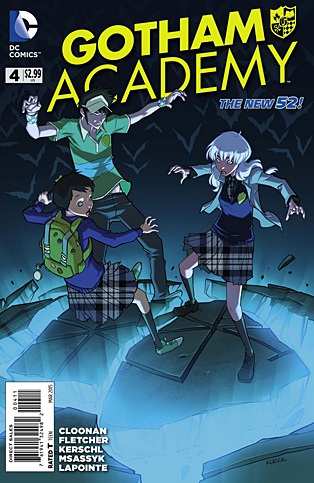 (DC – writer: Becky Cloonan and Brenden Fletcher; artist: Karl Kerschl)
(DC – writer: Becky Cloonan and Brenden Fletcher; artist: Karl Kerschl)
Gotham Academy #4 (on stands today, kids!) is a hoot!
I grew up with two very extremely different versions of Batman. The first was a Batman that was campy, ala the 1966 Batman TV series and Filmation’s New Adventures of Batman. The other was grim and gritty ala The Killing Joke and Death in the Family. Both versions were distilled in Tim Burton’s 1989 Batman movie, and I began to reconcile the two. Batman and Gotham City thrive in all manner of stories. But you know what story I haven’t seen Batman in? A teen drama.
Gotham Academy is an all-ages teen romance mystery series set in Gotham City’s most prestigious prep school. Thus far, main characters Olive Silverlock and Maps Mizoguchi, students at the school, have been looking into a haunting in the Academy’s sealed-off North Hall while partial amnesiac Olive is trying to remember just what happened to her last summer.
Last issue brought Olive and Maps together with rival Pomeline and her occult-style obsessed pals as a Gotham City-styled Scooby Gang. They broke into the school’s closed-off North Hall, hunting for the ghost of Millie Jane Cobblepot, and they apparently find the frightening phantasmagoria. Gotham Academy #4 picks up right afterwards.
I was on board with this series from issue 1, but the writing and art get better in every issue. Writers Becky Cloonan and Brenden Fletcher flex their long-game writing chops in Gotham Academy #4. They resolve part of the mystery, but that just leads to Olive and Maps discovering a secret symbol scrawled all over the school. Cloonan and Fletcher are building an interesting mystery, but the real selling point is how they write these characters. Olive’s frustration, Maps’ exuberance and Pomeline’s entitlement are all distinct voices that come through Cloonan and Fletcher’s scripts.
Artist Karl Kerschl’s art and colorists Msassyk and Serge LaPointe are doing work that doesn’t look like anything DC is publishing right now. Kerschl’s Headmaster Hammer is the stuff of high school nightmares. His panel layouts are inventive. This issue’s design around a secret staircase is particularly fun to look at. He also sneaks in some fun Easter eggs (Maps’ painting will have you running to your D&D Monster Manual). It’s one of the most unique-looking books out there.
Gotham Academy is fast becoming my favorite Batman-related comic (and I love Batman, Batgirl, Grayson and Batman ’66). Issues 3 and 4 delve further into the characters’ interpersonal relationships, while deepening the overall mystery. It’s a perfect mix of Batman, Scooby Doo, Dungeons & Dragons and Ranma ½ – it’s a book that wears its influences on its proverbial sleeve. I want these characters to solve the mysteries of the Gotham Academy and I want them to take however long they need to do so.
Full Disclosure: Unwinnable was supplied with a review PDF of this comic.
———
Star Trek/Planet of the Apes: The Primate Directive #2
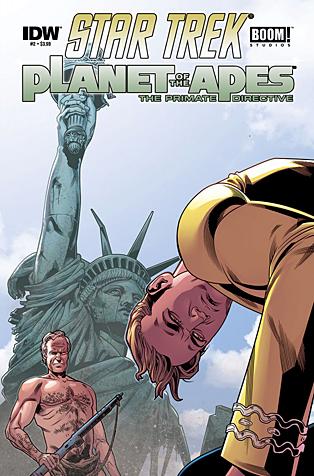 (IDW/Boom! Studios – writer: Scott Tipton and David Tipton; artist: Rachael Stott)
(IDW/Boom! Studios – writer: Scott Tipton and David Tipton; artist: Rachael Stott)
As a kid watching TV in the early ’80s, there were three things that would make me change the channel: Star Trek, Planet of the Apes and The 700 Club.
Planet of the Apes seemed to move too slow, and the color scheme and music made me kind of nauseous (I don’t know what it was, I had that reaction to a lot of ’70s movies and TV shows; it eventually went away.) Star Trek was a lame version of Star Wars (I know that’s wrong, but c’mon, I was like five!) And The 700 Club, well that took The Munsters out of reruns and that, friends, was an unpardonable sin to five-year-old me. Anyway, I digress… .
As an adult, I grew to appreciate both Star Trek and Planet of the Apes. While I enjoy the original Star Trek TV series, I never really got into their extended universe. The Planet of the Apes universe on the other hand, I find utterly fascinating. I’ve watched the movie series multiple times, actually like the TV show and bought many of the extended comic book series. So what happens when Star Trek and Planet of the Apes are thrown together in the microwave? The Primate Directive is what happens!
I like this “what if?” idea, enough to continue purchasing The Primate Directive even while I’m trying to cut back on my miscellaneous comics spending. On paper, and on first read, the books are a little too wordy. With a second reading, I understand the need for extensive Spock-ian exposition. I like the idea of the Klingons finding a portal to another universe and meddling there.
I’m sure both franchises will hit their famous beats and get in their respective catch phrases, but the real key to making The Primate Directive a strong series is to keep it as a miniseries. The Planet of the Apes universe has more definite boundaries, and the Star Trek crew has the easy out (via the portal) back to their own time and place. Any extensive meddling by the Star Trek folks would create ripples with long-term ill effects, even under the loosest definition of the space-time continuum. Also, a solid miniseries that leaves fans wanting more will add to the mythos of both franchises. Or just some weirdo fan fiction instead.
Star Trek has always drawn uber-devoted fans, so collector-types might be driven a little crazy. So far, each issue has multiple covers. For issue #2, I have the “regular cover,” but I like the look of the “retailer incentive cover” more. I don’t really know what a “retailer incentive cover” is for, I mean I can guess, but it’s a little too “inside baseball” for me (as a certain friend of mine might say.) These shenanigans take the fun out of things, which is what Star Trek and Planet of the Apes are really about.
———
Batman and Robin #38
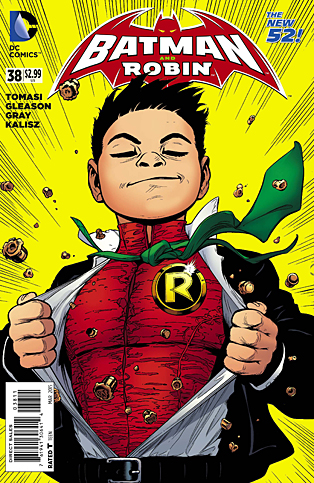 (DC – writer: Peter J. Tomasi; artist: Patrick Gleason)
(DC – writer: Peter J. Tomasi; artist: Patrick Gleason)
Lately I’ve been taking baby steps into the New 52. The revamped universe still seems like a silly marketing ploy that will one day be undone, and many of the alterations to established characters seems unnecessary. There is good stuff going on with a multitude of talented people putting out excellent work, but the question I keep asking myself is, “Why stain the excellence?”
While this makes me seem like a typical curmudgeonly comic book fan who wants all continuity to remain the same as it was in 1992, I’ll admit right now that my favorite thing DC Comics has done in the last ten years has been introducing a grown-up Damian Wayne into the Batman continuity to fight alongside his father as Robin. Well, technically Grant Morrison did it but still. Wayne is a blast of fresh air in the easily repetitious Batman mythos. When he was killed off by Morrison in Batman Inc. #8, I was bummed out that he giveth and taketh away such an awesome character. Which is why I loved Batman and Robin #38, an issue that spotlights the newly resurrected and super-powered Damian Wayne.
Having recently been revived by a Chaos Shard that granted him Superman-level powers (ah comic books), we’re given a glimpse into Damian’s head in this issue. Peter J. Tomasi does a wonderful job showing us that on the surface, Damian is cockier than ever, easily taking out some armed thugs in the beginning of the issue. By the end of the issue it’s apparent that this is a show, as he is internally tortured by his death, the apparent death of his mother (who he doesn’t know has also been resurrected) and the fact that his powers are more of a curse than a blessing.
Patrick Gleason gets some wonderful opportunities in this issue to let the art speak for itself. There are three instances that show that Damian respects life way more this time around, one silent one where he captures a firefly only to let it go like a child does, another where he pats one of Aquaman’s dolphins on the nose and another where he frees his tortured and deformed clones. Like many pre-teens, he’s fully wrapping his head around the concept of life and death, having the unfortunate experience of dying to be the incident that forces him to contemplate it. Gleason and Tomasi are a juggernaut of a creative team, and their work on Batman and Robin inches it ahead of the numerous other Bat-books.
There are many reasons why Damian being back is awesome, and the one major one is that it creates another layer to his father, Bruce. There’s only so many angles that one can use with Bruce Wayne, but in his interactions with Damian a new angle has been created. It’s a good thing, because it’s easy for Bruce to take a backseat to his supporting cast and rogues gallery. Sure, this issue is Damian’s book, but now that he is a confused, super-powered, aristocratic vigilante kid with assassins training, it makes Bruce his parent and guardian appear all the more human by comparison.
Damian is now aware that he is all of these things as well, where previously he was cocky and somewhat ambivalent about his status. What it looks like we’re going to see happen is that his otherworldly powers are making him realize that ultimately he’s just human, too, with a lot of growing up to do. It will be interesting to see where this story takes him, and I’m glad we’ve been given the opportunity to take the journey with him.
I’m sure his reply to all this would be a simple disapproving “*tt*.”

